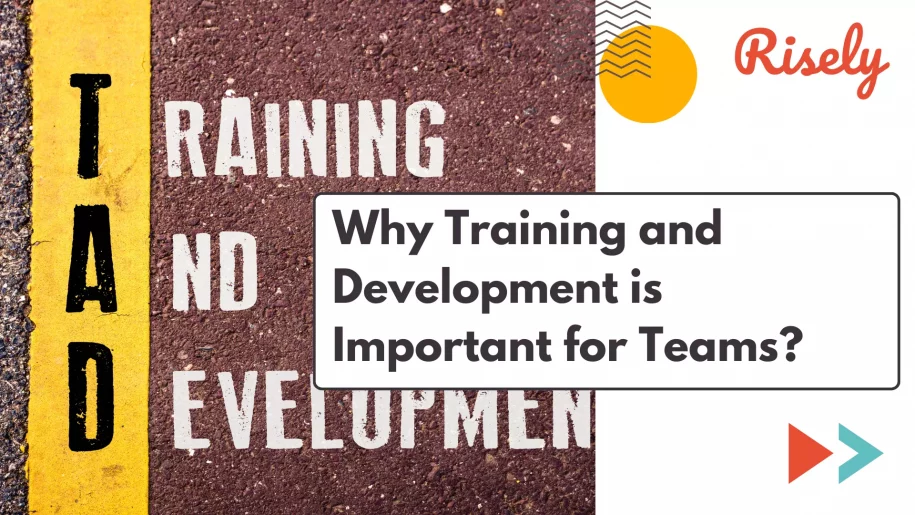Why Training and Development is Important for Teams?
As a team manager, you know that your team is the backbone of your organization. You want to ensure that they have the skills and knowledge necessary to succeed in their roles. That’s where training and development come into play. This blog will discuss what training and development are, why they are essential, and how they benefit teams. We will explore the difference between training and development and why both are crucial for employee growth. Additionally, we will explore the growing importance of training and development in today’s rapidly changing business landscape. By the end of this post, you will understand how investing in your team’s development can lead to improved employee retention, skill development for future leaders, empowered employees, increased workplace engagement, consistency across teams, and even enhanced company culture and reputation.Understanding Training and Development
Continuous training and development are vital for teams to acquire new skills and knowledge, stay updated with industry trends, and nurture leadership potential. It also demonstrates that employees are valuable, increasing job satisfaction and retention. In addition, practical training and development can improve team performance, productivity, and profitability. Therefore, investing time and resources in employee training and development is wise for any team manager aiming to achieve long-term success.Defining Training and Development
Training and development are critical components of any successful team. While training typically focuses on teaching specific skills or information, development focuses on personal growth and career advancement. Training and development are necessary for enhancing individual team members’ knowledge, abilities, and skills. Effective training and development programs should be tailored to the needs of the team or individual, with clear goals and measurable outcomes.The Difference Between Training and Development
One key distinction between training and development is the focus of each. While training typically involves teaching specific skills needed for a job or task, development aims to prepare individuals and teams for future roles or responsibilities. This broader scope can include building leadership skills, fostering innovation, and improving team communication. Both training and development are crucial for building a capable and motivated workforce to drive success. Striking the right balance between the two is essential to ensure teams have the skills they need in the short term while being prepared for future challenges.Why Training and Development is Important together?
Investing in both training and development is crucial for building a solid team and achieving organizational goals. While training focuses on teaching specific skills or knowledge to employees, development helps them grow and reach their full potential. Both are important for improving employee performance, engagement, and retention. Hence, a manager needs to understand the importance of training and development for teams. Additionally, training can help employees adapt to changes in technology or processes, while development can prepare them for future leadership roles. By investing in training and development, organizations show employees that they value their growth and are committed to success. Ultimately, this leads to a more skilled and engaged workforce that drives success.The Growing Importance of Training and Development
In today’s rapidly evolving strategic environment, the importance of training and development cannot be overstated. Effective programs can help teams improve their skills, increase productivity, and achieve better results. Investing in employee development extends beyond individual growth, as it also allows teams to stay competitive by adapting to changes in the industry or market. In addition, employees who receive regular training and development opportunities feel more engaged and motivated, leading to higher job satisfaction and retention rates. Ultimately, prioritizing training and development shows a commitment to employee growth and success, which can lead to a positive company culture and improved morale.Other Interesting Reads
Benefits of Training and Development for Teams
Introducing training and development programs for teams can significantly benefit team members and the organization. Apart from understanding the importance of training and development, managers should be aware of the benefits too. By enhancing skills and knowledge, team members can improve job performance, leading to increased productivity and better results. Moreover, it shows employees that their employer values them, boosting morale and job satisfaction. In addition, regular training keeps teams up-to-date with new technologies, processes, and trends, making them more adaptable and flexible in the face of change. In turn, this can contribute to a positive company culture that improves retention rates while contributing to an enhanced bottom line for the business.Improved Employee Retention
Investing in employee training and development can significantly impact employee retention rates. When team members feel valued and supported by their employer, they are likelier to stay with the team long-term. By providing opportunities for learning and growth, companies can establish a culture of continuous learning that keeps employees engaged and motivated. As a result, it improves retention rates and increases productivity and efficiency as team members become more skilled and proficient. Investing in employee training and development is an intelligent move for managers that can pay off in numerous ways.Skill Development for Future Leaders
Training and development programs can equip team members with essential skills, knowledge, and competencies to become future leaders. As the strategic landscape evolves, so do the challenges that teams face. Effective training programs can keep teams up-to-date with new trends and technologies, giving them a competitive edge. Moreover, skill development for future leaders is vital to ensure that teams continue to grow and thrive. By investing in training and development, teams can create a culture of continuous learning that attracts top talent and helps employees advance their careers within the organization.Empowering Employees
Employees can acquire new skills and knowledge through training and development programs that empower them to take on new challenges. Empowered employees feel a sense of ownership and responsibility toward their work, which can lead to increased job satisfaction and motivation. They are more likely to take the initiative and contribute new ideas to the team, improving overall performance. Training and development also show employees that they are valued by their organization, which can result in higher retention rates.Increased Workplace Engagement
Employee engagement is vital to the success of any team. Investing in training and development programs can increase workplace engagement among team members. When employees feel valued, supported, and empowered to take on new challenges, they are likelier to engage in their work. Training can also lead to greater job satisfaction and improved performance. By providing ongoing opportunities for learning and development, managers show that they value their team member’s contributions and are committed to helping them grow professionally. This, in turn, can lead to a more engaged workforce and better business outcomes.Improving Company Culture and Reputation
Providing training and development opportunities benefits the team and improves the overall company culture and reputation. Employees who feel valued and supported through training programs are more likely to be engaged, motivated, and committed to their work. This commitment can lead to increased productivity and performance, which ultimately reflects positively on the company’s reputation within the industry. In addition, by investing in training and development, companies can create a culture of growth and development that attracts top talent while retaining current employees who see a future with the organization.Conclusion
Training and development are crucial for teams to keep pace with the ever-changing market dynamics. It is a key driver of employee satisfaction, performance, and retention. Investing in your team’s training and development fosters a culture of continuous learning, which can increase employee engagement, productivity, and overall job satisfaction. Furthermore, it creates a sense of empowerment that leads to confidence and self-efficacy and helps them navigate their roles better.Identify the training needs of your team better with effective one-on-one meetings.
Make your one-on-one meetings better by removing the hurdles holding you back with the free one-on-one meeting assessment.
FAQs
What is the importance of development and training?
Training and development of teams can benefit managers in several ways. Firstly, it can improve team performance by enhancing the knowledge, skills, and abilities of team members. This can lead to more effective collaboration, problem-solving, and decision-making. Secondly, it can boost employee morale and engagement, leading to higher levels of job satisfaction and retention. Thirdly, it can help managers identify and address skill gaps, allowing them to better align team members.
How can training and development of teams help managers?
Training and development of teams can help managers improve team performance, boost employee morale and engagement, address skill gaps, and align team members’ strengths with business goals. By investing in their teams’ development, managers can build a more capable and effective workforce, which can lead to better outcomes for the organization.
Other Related Blogs
How To Build Learner Personas For L&D? Free Template
How To Build Learner Personas For L&D? Free Template For every learning designer, the root question is who will use this content. All your actions to ensure that the learning…
How To Use A Learning And Development Maturity Model?
How To Use A Learning And Development Maturity Model? How strong is your organization on the learning and development front? Answering that question is not super simple. Many factors are…
Learning Experience Platforms: A Brief Introduction
Learning Experience Platforms: A Brief Introduction When it comes to technology that supports workplace learning, our minds race to LMS. The humble learning management systems support a plethora of courses,…
7 Gen Z Workplace Expectations From A Manager
7 Gen Z Workplace Expectations From A Manager More and more members of Generation Z (Gen Z) are entering the workforce every year, and they are already challenging traditional workplace…


